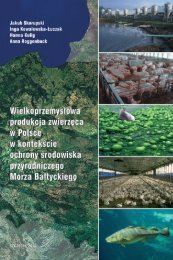best available technologies for manure treatment - Baltic Green Belt
best available technologies for manure treatment - Baltic Green Belt
best available technologies for manure treatment - Baltic Green Belt
You also want an ePaper? Increase the reach of your titles
YUMPU automatically turns print PDFs into web optimized ePapers that Google loves.
Best Available Technologies <strong>for</strong> <strong>manure</strong> <strong>treatment</strong> baltic sea 2020<br />
Best Available Technologies <strong>for</strong> <strong>manure</strong> <strong>treatment</strong> baltic sea 2020<br />
ANNEX E: TABLES WITH SHORT DESPRIPTION OF LIVESTOCK MANURE TREATMENT TECHNOLOGIES<br />
Best Available Techniques <strong>for</strong> <strong>manure</strong> <strong>treatment</strong> - <strong>for</strong> intensive rearing of pigs in <strong>Baltic</strong> Sea Region EU Member States Technical Report "Best Practice Manure Handling, Phase 2"<br />
Ref No. 31 Anaerobic digestion<br />
Brief description<br />
Description of the effect on leaching (positive<br />
or negative) of N and P<br />
Anaerobic digestion is a bacteriological fermentation process, whereby homogenised liquid biomass of a constant<br />
temperature of 30-45°C (mesophile) or 55°C (thermophile), and due to the ability <strong>for</strong> pumping with a maximal dry matter<br />
content of 12.5%, is fermented by anaerobic microorganisms, which are naturally occurring in especially cattle <strong>manure</strong>. The<br />
fermentation leads to the biogas production, which typically has a methane content of 60-65%. The hydraulic retention time<br />
is normally from 15-40 days, and the process happens in one or two stages, with the latter giving a slightly higher biogas<br />
production. Propellers are normally installed in the digestion tanks to ensure the digestate remains homogenous and gives<br />
a maximal release of biogas. The biogas production depend much of the type of biomass – see figures in the literature.<br />
Typically 15% (mesophile process) to 25% (thermophile process) of the energy production from a biogas plant is used to<br />
heat up the digester. About 3-4% of the energy is used as electricity consumption <strong>for</strong> pumping, mixing, transport and other.<br />
The remaining energy production can be used <strong>for</strong> farm purposes or sold.<br />
The community plants also serve as centres <strong>for</strong> re-distribution of <strong>manure</strong> in the region.<br />
Field trials per<strong>for</strong>med by Danish Agricultural<br />
Advisory Service have proven 17-30% higher<br />
field effect of N in digested livestock <strong>manure</strong>,<br />
compared to non-digested livestock <strong>manure</strong> –<br />
however, the increase of the field effect is<br />
higher <strong>for</strong> cattle slurry than <strong>for</strong> pig slurry,<br />
where<strong>for</strong>e we in this report assume 10%<br />
increase of the field effect. The digestate is<br />
more homogenous, e.g. less lumpy, nutrients<br />
more evenly spread out, making the<br />
digestate easier to seep evenly into the crop<br />
root area, enabling better nutrient uptake<br />
from crops.<br />
Innovation stage<br />
Investment price, <br />
Basic Variable<br />
Operational<br />
costs,<br />
per<br />
tonnes<br />
per kg saved N or P leaching Complexity of implementation<br />
Research<br />
Pilot<br />
Practice <br />
Major references<br />
Birkmose et al.,<br />
2007 (all issues)<br />
75.000 50 2,00<br />
Condition <strong>for</strong><br />
leaching<br />
reduction effect<br />
The digestate is<br />
used according a<br />
fertiliser plan.<br />
Certainty of<br />
in<strong>for</strong>mation<br />
Prices High<br />
Effect on<br />
leaching<br />
High<br />
Kg saved N leaching 9 = 10 % * 25,000 * 5 kg = 12,500<br />
kg. Price per kg saved N leaching = 0,70 (same as<br />
price <strong>for</strong> N in commercial fertiliser), assuming<br />
there can be produced 290 m 3 methane per tonnes<br />
volatile solids (VS);<br />
a payment <strong>for</strong> electricity of app. 102 per MWh, the<br />
annual revenues levels out the annual costs;<br />
run-off and emissions are unchanged, and that what<br />
is not taken up by the crop is leached to the aquatic<br />
environment sooner or later;<br />
the excess heat produced can be utilised; and<br />
the 10% increased field effect is taken into<br />
consideration in the fertiliser planning.<br />
Medium – biogas plants range from being<br />
small and simple to large and complex / high<br />
tech. There is generally a large economy of<br />
scale and large biogas plants would typically<br />
require a range of permits, including building<br />
permits and environmental approval.<br />
9 The size of the biogas plant example complies with the size of the model scenarios, table 5 section 2.1.6.<br />
9 The size of the biogas plant example complies with the size of the model scenarios, table 5 section 2.1.6.<br />
63<br />
Side 64<br />
63








